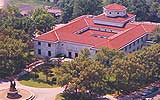Faculty
Christopher Drew Armstrong
Grappling with new problems that emerged from contemporary research in science, history and political theory, the most innovative architectural theorists of the French Enlightenment were compelled to abandon the Renaissance obsession with canons derived from ancient Roman monuments. The theorist and traveler Julien-David Leroy occupies a unique position among these thinkers: he was the first academically trained architect to travel to Greece (1754-55) and to publish a lavishly-illustrated book based on his experience. In a forthcoming study of French architectural thought in the late-eighteenth century, Armstrong examines the far-reaching impact of Leroy’s ideas on how architecture was understood, taught, and practiced.
As a leading academician and pedagogue during the Revolutionary period, Leroy emerged as a figurehead and mentor whose commitment to public education resonated with the highly influential precepts of Jean-Jacques Rousseau. After his death, Leroy’s students and colleagues took the unprecedented decision to commission a monument celebrating his career that was unveiled in the Louvre in 1804.
“Leroy was an exceptional figure,” notes Armstrong, “and his persona is inseparable from his theoretical interests - his experience as a traveler became the foundation of his architectural theory.” In Leroy’s thought, the observer is no longer the stationary spectator of the Renaissance but rather a mobile, dynamic subject consonant with Enlightenment ideas about the self. Stressing individual experience and change over absolute authorities and fixed principles, Leroy compared the impressions made by architecture to such experiences as walking through a garden in different seasons or during different times of day. “For Leroy, the experience of architecture is like moving through a landscape of forms in which the relationship between observer and environment changes constantly.”
Leroy’s understanding of architecture through individual experience was based on Enlightenment ideas about the acquisition of knowledge and a vision of history as cumulative and progressive. The development of architecture over time thus takes on great significance in Leroy’s work as an index to changing environmental, social and political conditions. “Leroy’s discoveries in Greece did not accord at all with the prevailing notion that ancient architecture was based on an immutable canon of beauty.” By emphasizing that cultural forms are contingent on historical and environmental factors, Leroy mapped out an approach to understanding architecture that would be amplified and developed into the present.
Prior to undertaking his doctoral studies, Armstrong completed a professional Bachelor of Architecture degree at the University of Toronto. He will be taking over as director of the Architectural Studies Program in September 2006.
